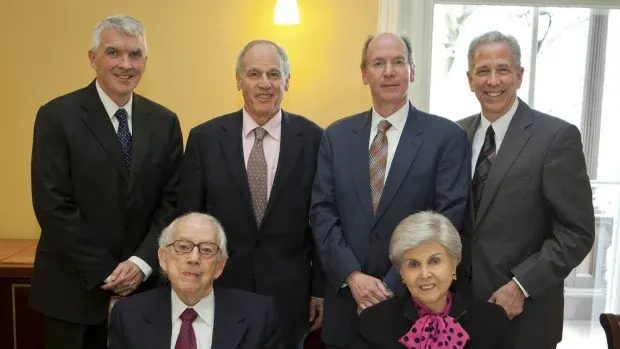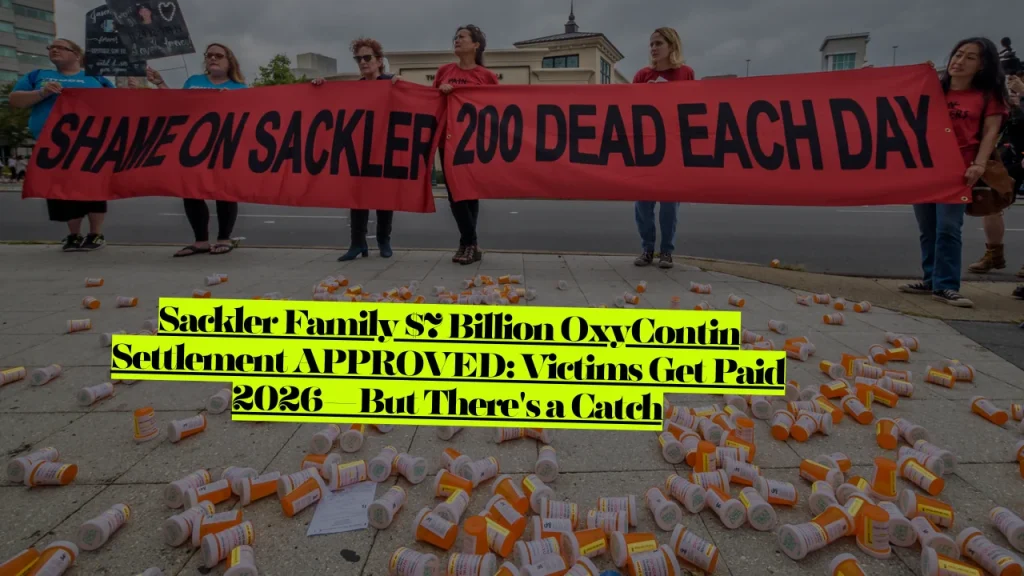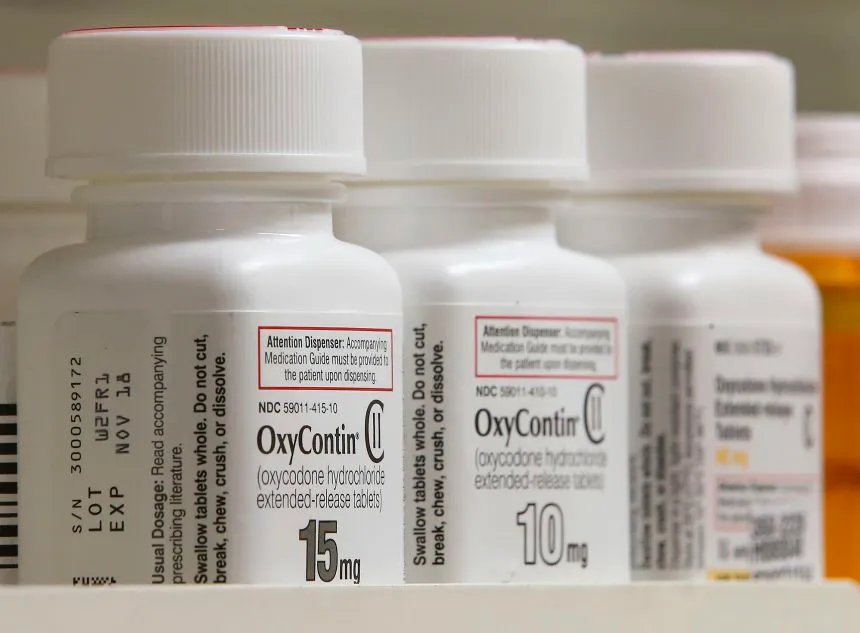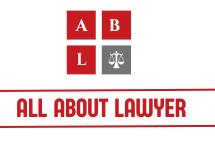Sackler Family $7 Billion OxyContin Settlement APPROVED, Victims Get Paid 2026—But There’s a Catch
A federal bankruptcy judge approved the Sackler family’s $7 billion opioid settlement on November 18, 2025, requiring the billionaire clan to pay up to $7 billion over 15 years while giving up Purdue Pharma ownership. Individual victims prescribed OxyContin can receive $8,000 to $16,000 starting in 2026, but those who opt out can still sue family members—whose assets sit in offshore trusts that may be unreachable.
Breaking November 2025: Judge Formally Approves Record Settlement
U.S. Bankruptcy Judge Sean Lane delivered his formal ruling on November 18, 2025, stating “This plan is not perfect. The court wishes it could do more to ease the suffering of the opioid crisis,” but concluded the settlement maximizes value for 900,000 opioid-related deaths since 1999.
The plan incorporates more than $6.5 billion from Sackler family members plus $900 million from Purdue Pharma, with over 99% of voting creditors supporting the updated agreement. This settlement replaces the Supreme Court-rejected deal that improperly shielded the Sacklers from lawsuits.
Judge Lane announced approval on November 14, 2025, then provided detailed reasoning in the November 18 ruling that marks the end of six years of bankruptcy proceedings.
What the Sackler Family Lawsuit Alleges
The lawsuits accused Purdue Pharma and the Sackler family of inventing, manufacturing, and aggressively marketing opioid products for decades, fueling waves of addiction and overdose deaths across the country. State attorneys general filed the nation’s most extensive complaints beginning in March 2019, targeting both the company and individual family members.
The allegations center on Purdue’s blockbuster painkiller OxyContin, which hit the market in 1996. Since then, opioids have been linked to hundreds of thousands of deaths in the U.S., with the deadliest stretch occurring since 2020 when illicit fentanyl was found as a factor in more than 70,000 deaths annually.
Plaintiffs claimed the Sacklers profited off fueling a devastating crisis while knowing the addiction risks. Sackler family members were collectively paid more than $10 billion by Purdue in the decade before they stopped involvement with the company in 2018, using about half for taxes.

Supreme Court Rejection Forced Renegotiation
The U.S. Supreme Court rejected the previous deal in June 2024, finding it would have improperly protected members of the family against future lawsuits by granting them immunity from opioid claims even though they were not personally declaring bankruptcy.
That ruling forced everyone back to negotiations. Under the new deal, the Sacklers and Purdue Pharma agreed to pay about $500 million more than under the previous deal without getting that big firewall against future lawsuits.
The revised settlement includes a critical change: entities that do not opt into the payments can still sue members of the family, addressing the Supreme Court’s concerns about improper bankruptcy protections.
Who Can File Claims for Sackler Settlement Payments
Individual Victims Eligible for Direct Payments
People with addiction and survivors of those who died must prove they were prescribed OxyContin to participate. Eligible individuals include:
- Persons prescribed OxyContin who developed addiction
- Survivors of individuals who died from opioid-related causes
- Children born with opioid withdrawal syndrome
- Family members of deceased OxyContin users
They could provide medical records or photos of prescription bottle labels, although many people don’t have such things dating back decades.
Voting Results Show Overwhelming Support
Out of more than 54,000 personal injury victims who voted on whether the plan should be accepted, just 218 said no. A larger number did not vote, but the settlement received near-unanimous backing from cities, states, counties, Native American tribes, and other creditors.
What Evidence You Need to Prove OxyContin Claims
Documentation Requirements
To qualify for individual victim payments, claimants must prove OxyContin prescription history:
Strongest Evidence:
- Medical records showing OxyContin prescriptions
- Pharmacy records documenting fills
- Hospital records related to opioid treatment
- Photos of prescription bottle labels with your name
- Doctor’s notes referencing OxyContin treatment
Alternative Documentation:
- Treatment records for opioid addiction
- Correspondence with healthcare providers about pain management
- Insurance records showing prescription coverage
- Witness testimony from family members
Those who do prove it could get payments of about $8,000 or around $16,000, depending on how long they took the drug and how many other people qualify.
How Much Compensation Individual Victims Receive
Payment Amounts Based on Duration
People with addiction and survivors of those who died who prove OxyContin prescriptions could receive payments of around $8,000 or around $16,000, depending on how long they received the drug and how many other people qualify.
Payment tiers depend on:
- Length of OxyContin prescription
- Total number of approved claimants
- Available funds in the $850 million victim allocation
Distribution Timeline
The money for individual victims is to be distributed next year in 2026. State and local governments receive funds to address the opioid crisis separately, with the majority flowing to government entities rather than individual victims.
Total Settlement Breakdown
The $7.4 billion settlement divides as follows:
- $6.5 billion from Sackler family members over 15 years
- $900 million from Purdue Pharma
- $850 million allocated to individual victims
- Remaining $6.55 billion to state/local governments and Native American tribes
A significant amount of settlement funds will be distributed in the first three years, with $1.5 billion paid out in the first payment, followed by $500 million after one year, an additional $500 million after two years, and $400 million after three years.
The Option to Opt Out and Sue Separately
Lawsuits Against Sacklers Remain Possible
The deal also sets aside up to $800 million for a legal fund that the Sacklers could use in the future if they’re sued. What that means is the cost of any future opioid litigation against the Sacklers would be paid for not by the family but out of this opioid settlement fund.
While not receiving immunity, the Sacklers secured significant financial protection. Family members are collectively worth billions, but much of their assets are held in trusts in offshore accounts that would be hard to access through lawsuits.
Judge Lane said that an alternative to the settlement — suing Sackler family members — instead of accepting the deal would take years “and success is not ensured,” in part because the family has consistently said they would fight claims against them.

Settlement Terms Beyond Money
Sackler Family Loses Purdue Control
Members of the Sackler family would formally give up ownership of the company. None have been on its board or received payments since 2018.
The company undergoes transformation:
- New name: Knoa Pharma
- Board appointed by states and creditor groups
- Public benefit mission focused on addiction treatment
- Prohibited from lobbying or marketing opioids
- Develops opioid overdose reversal medications
- Creates public document repository from decades of litigation
The plan will create a publicly available repository comprised of tens of millions of documents culled from decades of legal proceedings related to Purdue’s business.
Sacklers Barred from Future Opioid Sales
The settlement ends the Sacklers’ control of Purdue and their ability to sell opioids in the United States. Family members cannot profit from opioid sales anywhere globally under the agreement.
Current Status: Final Approval Granted November 2025
Three-Day Hearing Concluded With Minimal Opposition
Unlike with other proceedings, there were no protests outside the courthouse. A handful of objectors spoke Thursday at the hearing, sometimes interrupting the judge.
Some said that only the victims, not the states and other government entities, should receive the funds in the settlement. Others wanted the judge to find the members of the Sackler family criminally liable — something Lane said is beyond the scope of the bankruptcy court, but that the settlement doesn’t bar prosecutors from pursuing.
Appeal Filed But Settlement Moves Forward
One of those self-represented people told Lane during the virtual hearing Tuesday that she planned to appeal. However, the settlement proceeds with formal court approval, closing a six-year bankruptcy case.
Purdue lawyer Marshall Huebner told the judge that he wishes he could “conjure up $40 trillion or $100 trillion to compensate those who have suffered unfathomable loss.” But without that possibility, he said: “The plan is entirely lawful, does the greatest good for the greatest number in the shortest available timeframe.”
How to Join or Opt Out of Settlement
For Victims Seeking Individual Payments
The settlement has already been approved with voting completed. Those who voted to accept the plan and submitted proof of OxyContin prescriptions will receive payments in 2026. If you did not participate in the voting process but believe you qualify, contact:
- Your state attorney general’s office
- Purdue Pharma bankruptcy claims administrator
- Victim compensation coordinators in your jurisdiction
For Those Considering Separate Lawsuits
Entities or individuals who opted out of releases can pursue lawsuits against Sackler family members. However, consider:
- Offshore trust assets make collection difficult
- Litigation could take years without guaranteed success
- The $800 million legal defense fund protects Sacklers
- Settlement acceptance provides certain compensation
Christopher Shore, a lawyer representing a group of individual victims, said in court Friday that the settlement is a better deal than taking on Sackler family members in court. “Some Sacklers are bad people,” he said, “but the reality is that sometimes bad people win in litigation.”
What Filing Deadlines Apply
The settlement voting period closed before the November 14, 2025 approval hearing. Over 99% of voting creditors supported the updated agreement, which gave creditors the opportunity to opt out of releasing claims against company owners and others in exchange for a smaller settlement distribution.
Individual victims who participated in voting and submitted evidence will receive 2026 payments automatically. No further action required for those already approved.
For those who opted out: statute of limitations for opioid-related lawsuits varies by state, typically ranging from 2-6 years from when harm was discovered. Consult an attorney immediately to preserve claims.

What Makes a Strong Sackler Family Claim
Historical OxyContin Prescription Evidence
Strong claims demonstrate:
- Clear OxyContin prescription history spanning months or years
- Medical records showing opioid dependency diagnosis
- Treatment for addiction following OxyContin use
- Documented health consequences from prolonged use
- Timeline connecting prescription to addiction development
Wrongful Death Claims
Survivors of deceased OxyContin users need:
- Death certificate listing opioid-related cause
- Prescription records for the deceased
- Medical records showing addiction history
- Proof of relationship to deceased
- Documentation of financial/emotional damages
Neonatal Abstinence Syndrome Claims
Children born with opioid withdrawal qualify for compensation. Required evidence includes:
- Hospital records documenting withdrawal symptoms
- Mother’s OxyContin prescription history
- Treatment records for neonatal opioid withdrawal
- Long-term health impacts from in-utero exposure
How November 2025 Approval Changes Your Rights
The formal November 18, 2025 approval means the settlement becomes binding. Those who voted to accept receive automatic enrollment for 2026 payments. Those who opted out retain lawsuit rights but face significant challenges collecting from offshore Sackler assets.
Judge Lane said the states and individuals can get more than they would have if Purdue had been liquidated. In that case, he said, there would have been only $3.4 billion available — and $2 billion of that would have gone to the federal government as part of a criminal plea deal the company entered.
The $7 billion settlement represents the largest opioid agreement with individuals responsible for the crisis. It could close a long chapter — and maybe the entire book — on a legal odyssey over efforts to hold the company to account for its role in an opioid crisis connected to 900,000 deaths.
Why This Settlement Differs From Previous Attempts
No Immunity, But Financial Protections Remain
Unlike the rejected 2021 settlement, the Sacklers receive no blanket immunity. However, the Sacklers are still going to walk away with a lot of financial protection through the $800 million defense fund and offshore asset shields.
No Direct Confrontation Required
One feature that won’t be repeated under this new deal that was in a previous one: forcing members of the Sackler family to hear directly from people harmed by OxyContin. Unlike a similar 2021 hearing, no Sacklers testified during the November 2025 proceedings.
Faster Distribution Timeline
Payment to individual victims begins in 2026, with frontloaded distributions to states in the first three years. The previous settlement faced years of delays before Supreme Court rejection.
State-by-State Settlement Allocation
If approved, the settlement will deliver funds to the participating states, local governments, affected individuals, and other parties who have previously sued the Sacklers or Purdue.
New York expects to receive up to $250 million directly for opioid abatement programs. Attorney General Letitia James has now secured more than $3 billion total for New York to address the opioid crisis across multiple settlements.
Colorado and California joined bipartisan coalitions securing the settlement alongside Connecticut, Delaware, Florida, Illinois, Massachusetts, Oregon, Pennsylvania, Tennessee, Texas, Vermont, Virginia, and West Virginia.
Frequently Asked Questions
What are the recent November 2025 legal developments in the Sackler family lawsuit?
U.S. Bankruptcy Judge Sean Lane formally approved the $7 billion Sackler family settlement on November 18, 2025, requiring the billionaire family to pay up to $7 billion over 15 years while giving up Purdue Pharma ownership. Individual victims will receive payments starting in 2026.
Who can receive money from the Sackler family settlement?
People with addiction and survivors of those who died must prove they were prescribed OxyContin to participate, providing medical records or photos of prescription bottle labels. Children born with opioid withdrawal also qualify. Out of 54,000 personal injury victims who voted, over 99% accepted the settlement.
How much money will individual victims receive?
Those who prove OxyContin prescriptions could get payments of about $8,000 or around $16,000, depending on how long they took the drug and how many other people qualify. The money for individual victims is to be distributed next year in 2026. About $850 million of the $7.4 billion settlement goes to individual victims.
Can I still sue the Sackler family after this settlement?
The latest plan allows lawsuits against Sackler family members by those who don’t opt into the deal. Under the current agreement, entities that do not opt into the payments can still sue members of the family. However, much of their wealth sits in offshore trusts that are hard to access, and they have an $800 million legal defense fund.
What evidence do I need to claim Sackler settlement money?
They could provide medical records or photos of prescription bottle labels, although many people don’t have such things dating back decades. Strong evidence includes pharmacy records, doctor’s notes, hospital records, or treatment documentation showing OxyContin prescriptions and resulting addiction.
What happens to Purdue Pharma after the settlement?
Members of the Sackler family are agreeing to give up ownership of Purdue. The company will eventually get a new name — Knoa Pharma — and be operated with a public-interest mission. A board appointed by states will oversee the company, which will focus on addiction treatment medications.
When is the deadline to file a Sackler family claim?
The settlement voting period closed before November 2025 approval. Those who participated and proved OxyContin prescriptions will receive automatic 2026 payments. For those who opted out to pursue separate lawsuits, state statutes of limitations for opioid claims typically range from 2-6 years from harm discovery.
Legal Disclaimer: This information is for educational purposes only and does not constitute legal advice. If you believe you have been affected by the issues in the Sackler family lawsuit, consult with a qualified attorney to discuss your specific situation and legal options. Settlement payments, eligibility requirements, and filing procedures are subject to final court administration.
Related Resources:
- Class Action Settlement Updates & Filing Procedures
- Medical Device Litigation & Pharmaceutical Claims
- Consumer Protection & Data Breach Settlements
About the Author

Sarah Klein, JD, is a licensed attorney and legal content strategist with over 12 years of experience across civil, criminal, family, and regulatory law. At All About Lawyer, she covers a wide range of legal topics — from high-profile lawsuits and courtroom stories to state traffic laws and everyday legal questions — all with a focus on accuracy, clarity, and public understanding.
Her writing blends real legal insight with plain-English explanations, helping readers stay informed and legally aware.
Read more about Sarah
